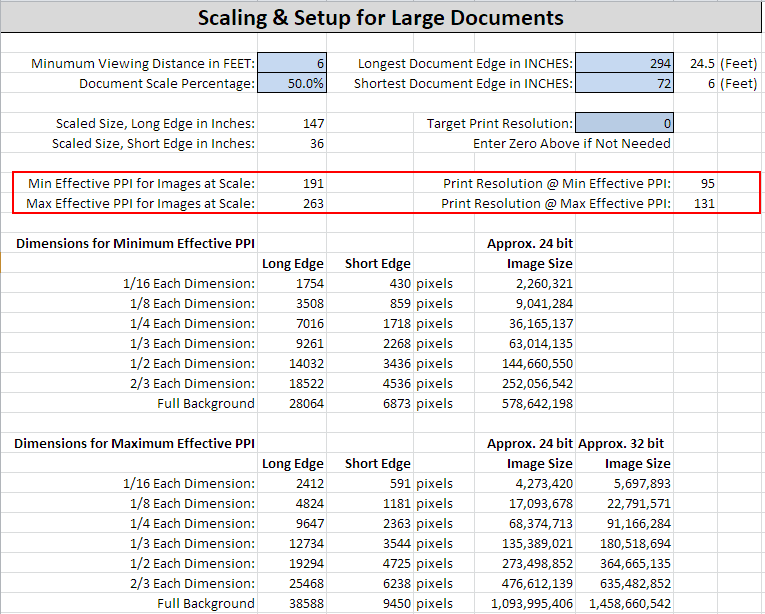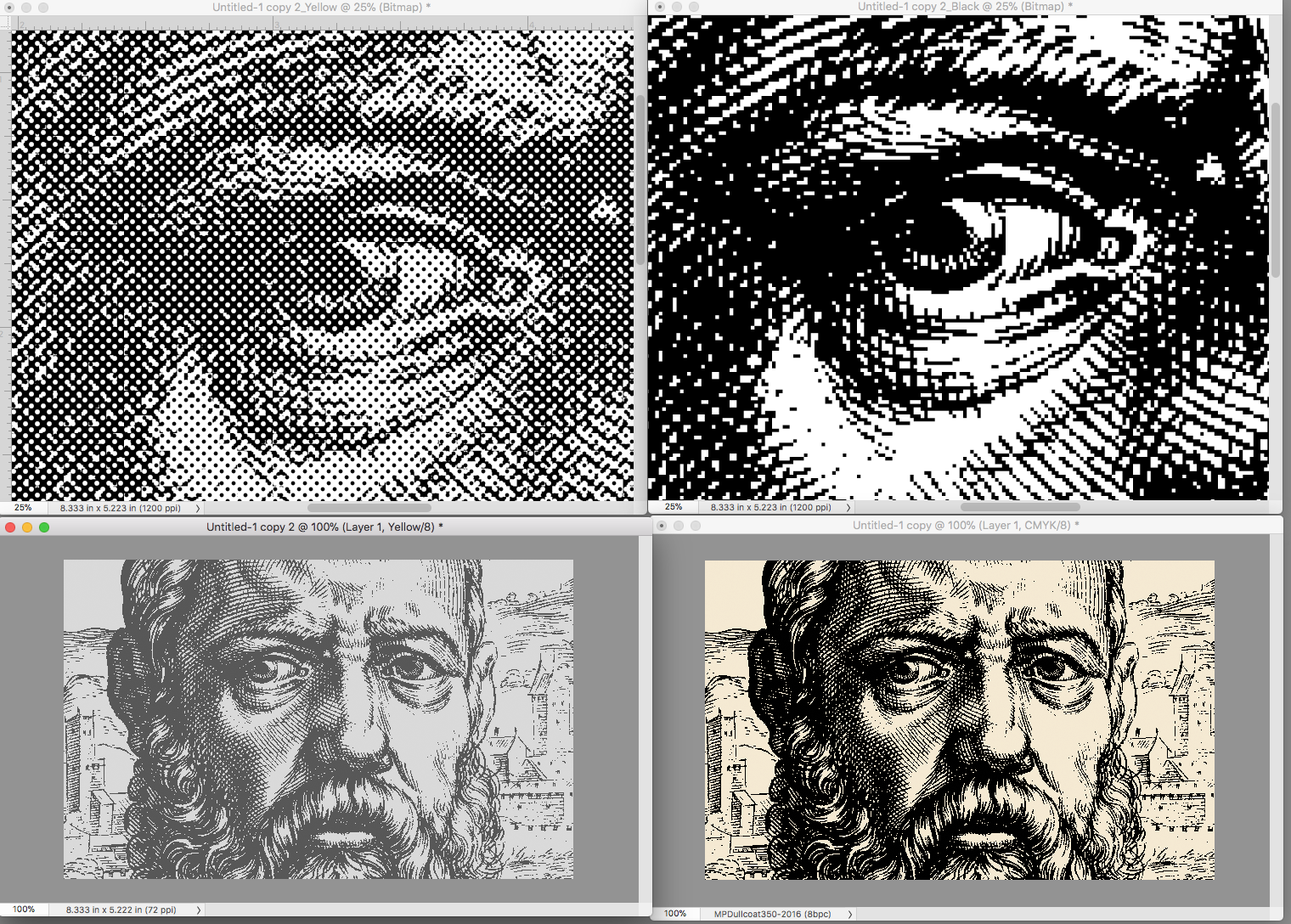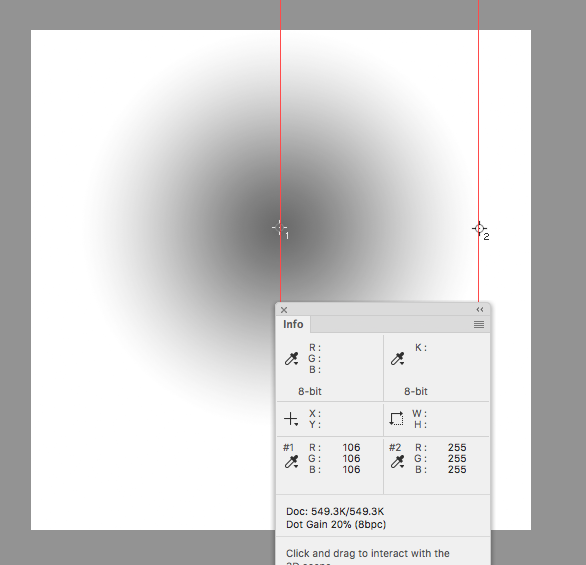- Home
- InDesign
- Discussions
- How to export pdf 3x size of file due to 216-inch ...
- How to export pdf 3x size of file due to 216-inch ...
Copy link to clipboard
Copied
I have an InDesign file at 294-inches by 72-inches (24.5-ft x 6-ft). I had to reduce the file by 1/3 size because InDesign limits it’s max working size to 216-inches and also because it made the file much easier to work with. Therefore, I working with a file that is 98-inches by 24-inches. The file consists of 2,979 3x3-inch images, which I’ve scanned individually at 300 dpi and placed in the file (linked, not embedded). I want to export the entire file as a PDF but I want to make sure that it’s at 300 dpi/full resolution once exported. I understand that each image within the file at 1/3 size has a working resolution at 900 dpi. Here’s where I’m confused: when I export the file at max resolution, the file exports at 98-inches by 24-inches. Although I’m not sure how to test this, I believe it exports at 900 dpi because when I enlarge the file, it seems to keep 300 dpi on screen. I do understand that screen resolution is different than print resolution, which is different than the working resolution within the file when reduced in size by 1/3. Here’s the question:
Is there any reason to believe that printing my exported pdf file at max resolution at three times the working file size file (thus, blowing up the 98-inches by 24-inches file to its full 294-inches by 72-inches) would result in less than 300 dpi resolution once printed?
Many thanks to anyone who can help.
 1 Correct answer
1 Correct answer
Just as an aside, you could have built the project full size. InDesign has an 216 in limit per page but can do up to 10 page spreads, so InDesign could create a 180 ft x 18 ft spread. When you output, just make sure it outputs as spreads, not pages.
As far as resolution goes, if you do work a 1/3 size, your images need to be 3 times the resolution requested by the print service. So if they asked for 300 ppi final resolution, your images need to be 900 (as was mentioned); if they asked for 150 ppi
...Copy link to clipboard
Copied
If you’re working at 1/3 scale and need 300 ppi images, then the images need to be 900 ppi.
HOWEVER…there is zero reason I can think of to print something that large with that kind of resolution. I would think 25-40ppi would be more than enough.
Copy link to clipboard
Copied
Thank you for your time and response. Why would you suggest 24-40 ppi? The images would be blurry... They are each individual images. It’s a collage of separate images that make a banner.
Copy link to clipboard
Copied
To answer a question, you can check the DPI in Acrobat easily enough. They would/should be 3 times the requisite dpi according to your 1/3 size.
But, have you talked to whomever is printing this large format job? I would doubt they want more than 150 dpi at full scale. No where I have had such work done have wanted more than that. So I typically design to that 150 dpi. (And no, 24-40 dpi would be appropriate for a billboard but not a large format job.)
I typically use the max, easily divisible scale percentage. In this case, I would use a 50% scale. Then the print establishment just needs to double the PDF size. But again, do talk to them and also make sure if they are intending on opening your PDF in CorelDraw or AI--a common occurrence in large format printing.
The screen shot below is assuming a couple things. One, that the typical viewing distance is 6 feet. Unless this is an eye-level, wall-mounted print, 6' away is pretty much not even achievable (it would be higher). The viewing distance affects what DPI one can use to basically fool the eye (hence billboards at 35 dpi appear continuous-tone from the highway). So with a 50% design scale and a minimum viewing distance of 6', you only need the DPI as shown in the red box and in particular, the two on the left side of it.

Copy link to clipboard
Copied
@MW Design Thank you again and again - this is tremendously helpful!
My project is - in fact - an eye-level, wall-mounted print. I’ve collected over 1300 post- it notes and I’ve used them to spell something so the banner is extensive in size.
I have spoken to the recipient of the project, who is also the printing the banner. I can doublecheck but I believe that we spoke about 300 ppi - I am, in essence, attempting to reproduce Post-it notes at the same size they were written on, and with the same resolution.
It’s possible people may even be closer than 6 six feet. In fact, it’s probable.
With this being the case, should I have scanned the notes in at a higher resolution than 300 ppi if I wanted to print the document full sized with zero loss of quality?
Copy link to clipboard
Copied
In that case, yes, they probably should have been scanned higher but 300 ppi is, for the most part, an old wives tale.
While we can offer you general advice here, it's always best to talk to the printer. Can you get a test print from them? It's no impossible that going to 50% and using your current scans could yield results that are just fine.
Copy link to clipboard
Copied
BobLevine wrote
... 300 ppi is, for the most part, an old wives tale.
There is a pure technical reason for that number.
When the first PostScript imagesetters were introduced – quite possibly the first ones to be able to accurately image printer's halftone dots –, the high-end machines could image at 2400 pixels per inch. To be able to form a halftone dot with at least 256 values of gray (the maximum number at that time), a grayscale dot needs to be at least 16x16 = 256 black-and-white pixels. A division shows that the highest possible grayscale resolution is then 2400/16 = 150 of such dots. Then this value times 2 is to prevent artifacts showing up if the original bitmap is not exactly aligned with these dots; hence, 300 dpi.
Current high-end imagesetters can output at a resolution in excess of 4000 dpi; a practical limit there is the halftone dot resolution that still can be accurately reproduced on paper.
Of course this is only relevant for work that is reproduced at 100%. If the output size is going to be larger than the original, one needs to take the viewing distance as the most important factor. E.g., for a full color calender with highly detailed photographs, you want the highest possible resolution, but if it's a six-meter wide poster that noone is going to look at from really close up, a lower resolution is not only advisable (as in: a way smaller file) but a higher rez is also totally unnecessary.
The entire stage decor of the Rolling Stones "Steel Wheels" tour was printed using then-cutting edge PostScript printers. It reportedly contained halftone dots "as big as your fist" – but of course no-one in the audience was able to see that.
Copy link to clipboard
Copied
Then this value times 2 is to prevent artifacts showing up if the original bitmap is not exactly aligned with these dots; hence, 300 dpi.
I think it's the lining up part that's the old wive's tale. You could have a high contrast image with details containing little or no halftone screen—think of a colored engraving where the fine lines approach line art. Those kinds of images would improve with higher resolutions. Conversely, an image could have no edge detail—think of clouds or a drop shadow. In that case there would be no detail to resolve and the image would need considerably less resolution.
Copy link to clipboard
Copied
No, as soon as an image is grayscale, those fine lines would also be rendered in halftone dots. Line art can be best printed as a pure black-and-white bitmap. These will transfer to imager pixels – not halftone dots – as accurately as the lowest of their resolutions allow.
The alignment of pixel "blocks" onto halftone dots becomes immensely visible if every single halftone dot gets cut off at preciesely the same position. Then you will see horizontal and vertical line artefacts. Slamting the halftone grid at 45 degrees is one way to counteract it, but it'd still be a factor.
Copy link to clipboard
Copied
No, as soon as an image is grayscale, those fine lines would also be rendered in halftone dots.
But there could be fine detailed parts of a grayscale image that have no gray values—the detail edges are defined as black or white pixels. If there was a magic ratio that affected quality there should be a discernible difference between 290ppi and 300ppi.
Here's a case where the black plate of a CMYK image has no gray values and would output with no halftone dots—the difference between 300ppi and 400ppi would likely be visible.

On the other end of the extreme are images with little edge definition and not much to resolve (i.e. clouds)
So this grayscale gradation has 150 steps of gray over 1". There would be no difference between 150ppi and 300ppi here because at 300ppi the gray pixels would simply repeat, both resolutions would output the same halftone screen.

Copy link to clipboard
Copied
Most welcome...
Even with eye-level wall banners, 300 dpi is above what is needed at a 1:1 scale, which ID cannot do anyway. You can do a 1:1 scale in CorelDraw, even Affinity Designer. But there is a hoop to jump through so that it can display in a reader or be seen at RIP-time, though I think I recall the requisite user scale in a pdf is now alterable in Acrobat DC...or will be. Not certain about that. And there was an inquiry by Adobe about lifting the artboard size in AI, but that too would need a little help from the Acrobat team to make it seamless.
At 50% scale, a bitmap needs double the resolution so it can hit the target when doubled in size.
While the print service maybe spouting 300 dpi at 1:1, they themselves couldn't do it unless they know how to produce it in CD. I've done 400"+ via CD, but it isn't common and not a lot of print establishments will opt to deal with it. And I can pretty much assure you that a target of 300 dpi at 50% scale will produce a good print at a nominal viewing distance of 3 feet, which then resolves to 150 dpi at 1:1. The inkjet technology used in large/grand format will produce a nice print.
The spreadsheet uses the standard formula for viewing distance. I can rerun it if desired...it takes seconds.
Copy link to clipboard
Copied
I agree with Bob. The best advice you will get here is "call your printer." The only person who knows exactly what your printer needs is your printer.
Copy link to clipboard
Copied
Just as an aside, you could have built the project full size. InDesign has an 216 in limit per page but can do up to 10 page spreads, so InDesign could create a 180 ft x 18 ft spread. When you output, just make sure it outputs as spreads, not pages.
As far as resolution goes, if you do work a 1/3 size, your images need to be 3 times the resolution requested by the print service. So if they asked for 300 ppi final resolution, your images need to be 900 (as was mentioned); if they asked for 150 ppi final res, yours need to be 450.
What is the print service asking for? When I have done banners, my vendor wanted the entire file as raster, including any text or vector art.
Copy link to clipboard
Copied
You’d still need to be careful about the 200 inch limit in PDFs.
Copy link to clipboard
Copied
You’d still need to be careful about the 200 inch limit in PDFs.
Unless one produces an eps or postscript and distill using a certain Distiller profile which sets the user units. But one still needs to check with the output provider to see if they can use it...all the large/grand format printers I have used can do so.
Copy link to clipboard
Copied
Not sure I understand that.
If you export a PDF from InDesign it’s going to get chopped off at 200” and I don’t think you’ll even get a warning about it.
Note: the above is based on what I saw on older versions of ID. Not sure if anything’s changed.
Copy link to clipboard
Copied
Maybe in ID. Dunno as I do not do large format work in it. I don't think it is the best option. So let me try...
Nah, it works. A 206" page in ID with 1" bleed.

Copy link to clipboard
Copied
Excellent. Thanks for checking.
Copy link to clipboard
Copied
Thanks, Bob. I used CS6, btw.
Copy link to clipboard
Copied
I thought the page size limit was removed back in Acrobat 7/PDF 1.8. It was buggy at first, but has been improved with newer versions of Acrobat.
Copy link to clipboard
Copied
Nope. Still odd limits in both ID and AI.
Copy link to clipboard
Copied
Newer PDFs have something like a 15K inch sq. limit, so I did a quick test...
Created a 240 in square document in CorelDRAW.
Exported to PDF and opened in Acrobat Pro. File was clipped to 200 in.
Installed Foxit Reader (similar to Adobe Reader) and opened same PDF.
It showed at the correct 240 in size.
Tried another document at 150 ft sq in CorelDRAW (it's maximum size)--same results--page showed at correct size in Foxit Reader.
Conclusion...
Adobe is not following current page size PDF specifications in InDesign or Acrobat Pro. (Did not check Adobe Reader.)
Copy link to clipboard
Copied
All true about Foxit (and a few other PDF readers).
But see if any print establishments will use it for printing large format work. I doubt any would use it. RIPs generally see what Acrobat sees. If Acrobat cannot see it, neither will a RIP (and that applies to non-Adobe RIPs too).
I do most large format work in CD. Always have. I have used XDP in the recent past when they changed their page size limitation. And I have used AD once (heck, I have also used PS with the PSB file format too). What I like about using a vector design application is I can design at 1:1, but then change the page size to a scale that Acrobat can natively see, group the design (with the line scale on) and scale the design down to the new page size and simply export the PDF at or below the 200" limit. Everyone wins.
Copy link to clipboard
Copied
IDEAS-Training This is especially helpful:
"Just as an aside, you could have built the project full size. InDesign has an 216 in limit per page but can do up to 10 page spreads, so InDesign could create a 180 ft x 18 ft spread. When you output, just make sure it outputs as spreads, not pages. As far as resolution goes, if you do work a 1/3 size, your images need to be 3 times the resolution requested by the print service. So if they asked for 300 ppi final resolution, your images need to be 900 (as was mentioned); if they asked for 150 ppi final res, yours need to be 450."
Regarding the print service, I have a meeting with them mid-January and will be able to ask what they need exactly at that time. I do know they wanted 300 ppi as a possibility. I may study up on ID and see how to redo the file as spreads so that I can whatever the print service requests, up to 300 ppi, which they originally asked for.
Many thanks to all who have participated on this thread. I'm just beginning my studies in Imaging Technology in a couple weeks and this has all been profoundly helpful.
Find more inspiration, events, and resources on the new Adobe Community
Explore Now


